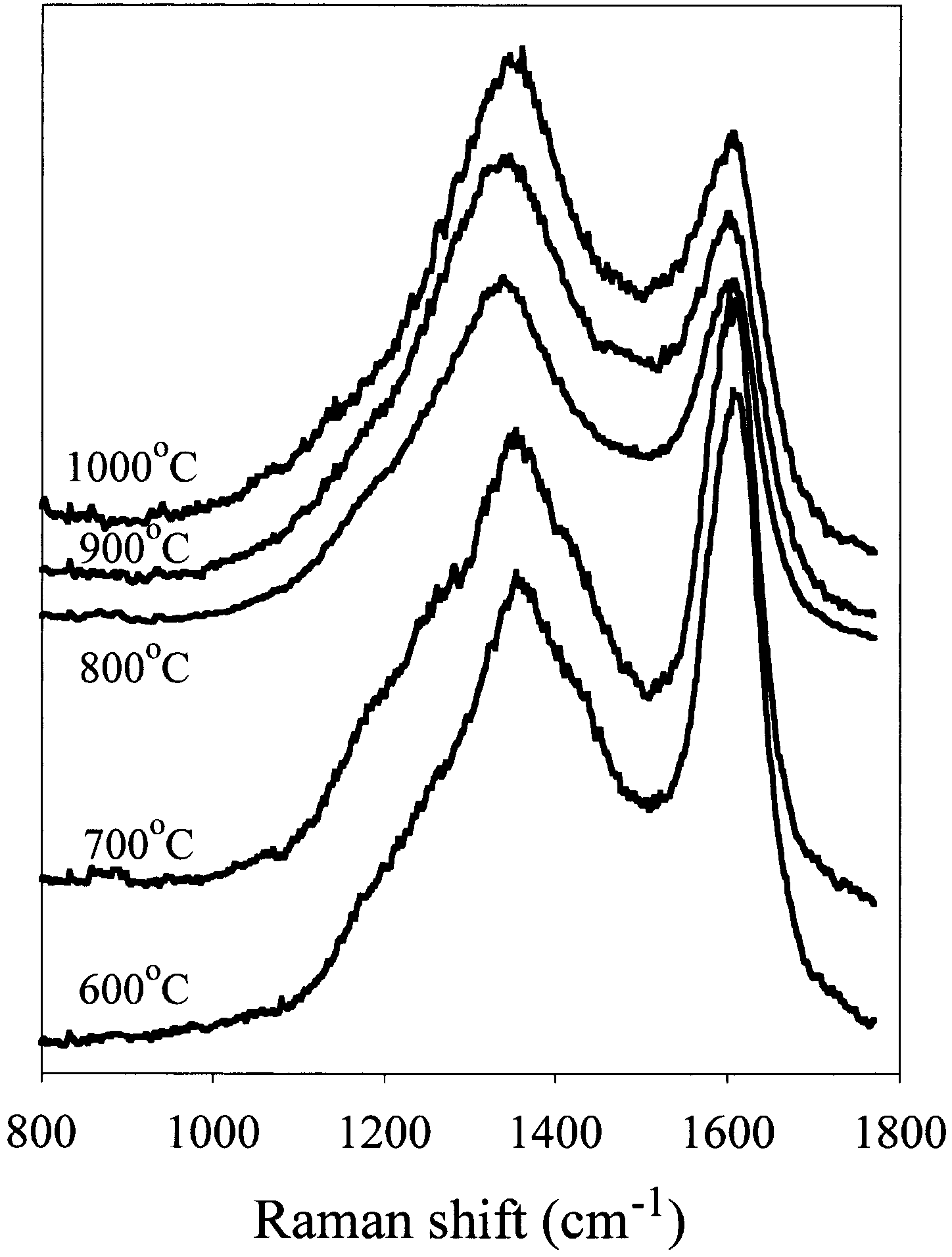Positive and negative photoresists, which are commonly used in the semiconductor industry, were deposited on silicon wafers by spin coating and then pyrolyzed at temperatures of 600–11008C in an inert environment to produce thin carbon films.Raman spectroscopy, X-ray photoelectron spectroscopy (XPS) and scanning probe microscopy involving current-sensing atomic force microscopy (CS-AFM) were utilized to characterize the properties of the carbon films.Raman spectroscopy showed two broad bands at approximately 1360 cm and 1600 cm , which deconvoluted to four Gaussian bands.The origin of these bands is y1 y1 discussed.CS-AFM showed that the surface conductance increased with increased pyrolysis temperature, and the results are consistent with measurements by a four-point probe method.The XPS spectra revealed the presence of oxygen functional groups (C=O and C–O) on the carbon surface.The relative fraction of oxygen, OyC ratio, decreased as the pyrolysis temperature increased, in agreement with published results.The full-width at half-maximum of the C peak obtained by XPS also decreased 1s with increasing pyrolysis temperature.
Carbons ranging from bulk commodity carbons (i.e. coke, natural graphite, synthetic graphite) to the more specialty carbons (e.g. carbon aerogels, carbon fibers, mesocarbon microbeads) are available for industrial applications.The morphology and crystallographic properties of these materials vary significantly.For example, highly oriented pyrolytic graphite (HOPG) has a wellordered surface structure with a significant fraction of basal-plane sites and a small fraction of edge sites. However, high-surface-area amorphous carbon blacks have a surface that consists of predominantly edge sites. More recently, we initiated a project to evaluate thin carbon films for use in microbatteries w1–4x.Pyrolyzing photoresist that was initially spin coated on a silicon wafer produced these carbon films.
A variety of methods such as deposition from plasma w5–9x, ion sputtering w10,11x, cathodic arc deposition w12,13x and laser evaporation of graphite w14,15x produce carbon films.The term ‘diamond-like’ is often used to describe these carbon films because there is evidence for sp bonding of the carbon atoms in a 3 fourfold structure like diamond.The properties and composition of the carbon films are strongly dependent on the fabrication method, and several reviews are available on these subjects, e.g. by Tsai and Bogy w16x, Robertson w17,18x, Andersson w19x and Hauser w20x. More recently, Raimondi et al. w21x used laser ablation to carbonize a polyimide to form ring- and cone-like carbon structures.
Our studies showed that the physicochemical properties of the carbon films are strongly dependent on the organic precursor and the processing techniques that are used.Several techniques were used to characterize the surface properties of the carbon films.These include Raman spectroscopy, X-ray photoelectron spectroscopy (XPS) and scanning probe microscopy involving atomic force microscopy (AFM).The surface topography of the carbon films was observed on a micro- and nanoscale by AFM.In addition, current-sensing AFM (CS-AFM) was used to probe the surface conductance of the carbon film.The crystallographic structure was ascertained from analysis of the Raman spectra.Information on the surface concentration of oxygen associated with functional groups was derived by XPS.The net result is that a clearer picture of the surface properties of carbon films produced by pyrolyzing photoresist was obtained by combining the information obtained by these techniques, and the results are described in this paper.This study is an extension of our efforts to utilize pyrolyzed photoresist to fabricate microelectrode structures that may be useful in microsensors and microbatteries w1– 4x.

Fig1
The methods used in this study to examine the carbon films, Raman spectroscopy, CS-AFM and XPS, are essentially surface-sensitive techniques.By combining these techniques, an array of results were obtained to characterize the surface properties of the carbon films produced by pyrolysis of photoresists.The major focus of this paper will be on the characterization of the carbon film obtained by pyrolyzing positive photoresist OIR-897.
AFM studies w30,31x of carbon films derived from pyrolyzed positive photoresists (AZ-4330 and OIR-897) clearly showed that an atomically smooth surface is obtained from a pyrolyzed photoresist.The AFM images of the carbon films revealed a compact surface structure that appears to be relatively smooth, uniform and free of cracks and large aggregates.This structure is typical of the carbon films obtained by pyrolysis at 700–10008℃ in an inert atmosphere.Statistical analysis of this featureless surface revealed a peak-to-valley distance of ;10 A and root-mean-square (r.m.s.) roughness of ;2 ˚ A over an area of 0.5 mm=0.5 mm.
下一篇: 二维光子晶体激光阵列的光刻图谱调谐